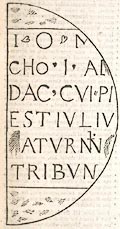|
|
Roman Inscription,
Lanercost
Mr URBAN,
Carlisle, June 8, 1744.
THE following Roman Inscription, being the Head-stone
of the upper Passage betwixt the Pillars and the Out-wall of
the old Abbey of Lennercost, has escaped the
Observation of all Antiquaries by its obscure Situation. It
was discovered by two Masons at Work there, who informing me
of it, I went this Day to examine it, and by help of a
Ladder noted down these Characters
IOVI OPTIMO MAXIMO COHORS PRIMA AETIAE DACORUM CUI PRAEEST
JULIUS SATURNINUS TRIBUNUS.


|
|
|
The Rest had been obliterated by the Workmen at building the
Abbey. To understand it, we are to consider, that besides
the legionary Troops employ'd in the Roman Service,
there were ten auxiliary Cohorts, which made a Legion, of
foreign Troops, and assumed the Name of the conquer'd
Province to which they belong'd, and sometimes added another
Title in Honour of some of their Emperors, under whom they
were probably inlisted. This Cohort was then called AElia
Dacica; AELIA, in Honour of Adrian, who was
stil'd Titus AElius Hadrianus, and DACICA, from their
Country, Dacia comprehended all that Tract of Ground
North of the Danube to the Carpathian
Mountains, betwixt the Rivers Tibiscus and
Pruth, comprehending now good Part of Hungary,
all Transilvania, Moldavia and
Walachia. We have many other Stones which mention
this Cohort, particularly at Burd-oswald, the
Roman Amboglana; here the Notitia, which was
written under Theod. junior, places this Legion which
seems to have succeeded the Legio Sexta victrix, and
very likely garrison'd this Place to the final Departure of
the Romans from Britain. The Name of the
Tribune is different from that on any other of the Stones
ascribed to this Cohort. Whilst I was copying this Stone,
the Farmer's Son who resides at the Abbey, told me there
were some kind of Letters over a Stair case in an old Tower,
belonging to their House, which excited my curiosity to
visit them. I found it a Piece of as valuable Inscription as
any yet discovered in Britain, whether we attend to
the odd Irregularity of the Letters, the Shape, or Variety
of them; for there are Roman, Runic, and
Saxon, sometimes in the Compass of a single Word; and
'tis hard to say which of the Alphabets of these three
Nations has the greatest Share in the Composition. 'Tis
great Pity that it is not compleat, the Workmen having cut
it to adjust it to the Place, so that Part is covered by the
adjoining Stones which cannot well be remov'd.
The Form of the Letters is exactly as below


In my Opinion we are to read it
Regni nostri primo mense tertio Anno Domini Millesimo
Trecentesimo Septimo.
Edward II. began to reign that very Year 1307,
July 7, so that the third Month after would still
happen in that Year specify'd, and seems to be a Grant for
building the Out-conveniences to the said Abbey. The
Singularity of the Method of Writing in that obscure Century
renders it very remarkable; for in the single Word
Trecentesimo, 'tis difficult to say which Alphabet
the Latter T belongs to, but it mostly resembles the
Celto-Scythic, R is Roman, E is Runic,
M, the old Gothic, and in other Words some are
Saxon.
Abbey Lennercost stands on the North-Bank of the
River Irthing, and is of its Kind as near a
Gothic Structure as any left. It was built by
Hubert de Vallibus to expiate a Murder, but fell
several Times into the Hands of the Scots, who often
plunder'd it of its Treasures. The Roman Wall which
passes just above it has furnished the principal Materials
for this Edifice, which contains Inscriptions on Monuments
of the next Century to Edward's, but these have an
Uniformity of Characters, and are not so barbarously
confounded as the above. I shall send you one or two as
Specimens soon, but have already exceeded the Bounds of a
Letter.
Yours, &c. G. SMITH.
(See the Inscription p.340)
|












 Gents Mag 1744 p.369
Gents Mag 1744 p.369